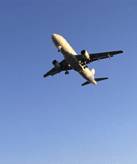
THURSDAY, March 4 (HealthDay News) — Air travel could raise the risk for experiencing heartbeat irregularities among older individuals with a history of heart disease, a new study suggests.
The finding stems from an assessment of a small group of people — some of whom had a history of heart disease — who were observed in an environment that simulated flight conditions.
“People never think about the fact that getting on an airplane is basically like going from sea level to climbing a mountain of 8,000 feet,” said study author Eileen McNeely, an instructor in the department of environmental health at the Harvard School of Public Health in Boston. “But that can be very stressful on the heart. Particularly for those who are older and have underlying cardiac disease.”
McNeely and her team are slated to present their findings Thursday at the American Heart Association’s Cardiovascular Disease Epidemiology and Prevention annual conference in San Francisco.
The authors noted that the number one cause for in-flight medical emergencies is fainting, and that feeling faint and/or dizzy has previously been associated with high altitude exposure and heartbeat irregularity, even among elite athletes and otherwise healthy individuals.
To assess how routine commercial air travel might affect cardiac health, McNeely and her colleagues gathered a group of 40 men and women and placed them in a hypobaric chamber that simulated the atmospheric environment that a passenger would typically experience while flying at an altitude of 7,000 feet.
The average age of the participants was 64, and one-third had been previously diagnosed with heart disease.
Over the course of two days, all of the participants were exposed to two five-hour sessions in the hypobaric chamber: one reflecting simulated flight conditions and the other reflecting the atmospheric conditions experienced while at sea level.
Throughout the experiment, the research team monitored both respiratory and heart rhythms — in the latter instance to specifically see whether flight conditions would prompt extra heartbeats to occur in either chamber of the heart.
The absolute risk for experiencing extra heartbeats did not appear to be greater while passengers were in flight conditions. However, in instances where cardiac irregularity had occurred the authors found that the risk for experiencing a higher rate of such extra heartbeats was “significantly higher” while airborne among those passengers with a prior history of heart disease.
A total of eight participants with diagnosed heart disease experienced a run of two extra lower-chamber heartbeats while in flight-simulated conditions, while seven participants with diagnosed heart disease experienced a similar run of three or more erratic beats.
The research team called for further study of passengers — with and without heart conditions — while in actual flight, to better determine who might be most at risk for such cardiac complications.
“The fact is that flying at 8,000 feet probably wouldn’t really be of any significance to someone who is young and healthy,” McNeely noted. “But the number of older and often debilitated people you see flying is much greater today than it was just a few years back, as flying has become much more accessible to everyone. And a lot of the standards that were set for air travel were made based on research from the 1950s. So we don’t have a lot of information on how air travel impacts that group,” she added.
“I should say that we can be heartened to know that looking at statistics about medical incidents on board airplanes that they’re very, very rare,” McNeely pointed out. “And this study needs to be done again on a larger group of people. But there might be some greater risk for certain groups. So I would say that for older individuals who have a cardiac or lung condition, it’s worth considering talking to your doctor, and maybe even have some preliminary testing before flying.”
Dr. Samuel Goldhaber, director of the venous thromboembolism research group at Brigham and Women’s Hospital in Boston, agreed that although the study is “intriguing,” it is too early to draw definitive conclusions.
“Because this study is exploratory and small, I think there needs to be a lot more follow-up,” he said. “But it is certainly worthy of further exploration, because I’m not sure that concerning commercial airline flights there’s been a study like this one before.”
Goldhaber added, “We know that patients get pulmonary embolism while they’re flying. So we can be certain that there is some physiological change during air flight. But we don’t yet have any good mechanism to explain that. So this is an interesting investigation.”
McNeely pointed out that although the current research was funded in part by both the U.S. Federal Aviation Administration (FAA) and The Boeing Co., “the findings and conclusions are those of the authors and do not reflect the agreement or endorsement of FAA or Boeing.”
More information
For more air travel health tips, visit the American Academy of Family Physicians.

